 As I edited and sourced and fact-checked J. Ross Baughman’s bold and thoughtful analysis of Robert Capa’s brief D-Day experience on Omaha Beach on June 6, 1944 and the resulting images for publication here, two radically different narratives began running simultaneously in my mind’s eye.
As I edited and sourced and fact-checked J. Ross Baughman’s bold and thoughtful analysis of Robert Capa’s brief D-Day experience on Omaha Beach on June 6, 1944 and the resulting images for publication here, two radically different narratives began running simultaneously in my mind’s eye.
The first, inevitably, reprised the legend: Heroic Robert Capa, cool under fire, making four rolls’ worth of 35mm exposures during the landing and the battle — unwittingly ruining one with saltwater damage in the process, leaving some 106 latent images — and shipping them via courier to London. There a harried, inexperienced teenage lab assistant ruins all but 11 of the remaining pictures by closing the door of a drying cabinet after they’re developed, so the film strips overheat and the emulsions melt. LIFE‘s London picture editor John Morris and Capa magnanimously forgive the well-intentioned “darkroom lad” for his awful mistake, and the surviving images becoming iconic as the “Magnificent Eleven.”
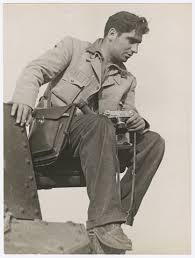
Robert Capa holding his 35mm Contax on a Japanese tank captured at the Battle of Taierzhuang, Xuzhou Front, China, April 1938. Photographer unknown.
The second account not only has more nuances but constitutes, in fact, an almost entirely different story. Its main protagonist, Capa, already an international star in the world of photojournalism, has an untypical panic attack during the landing, mishandles his equipment in such a way that he overexposes most of his film, and runs away from the battleground after 30 minutes or less.
When the film gets processed in London, Morris discovers, to his horror, that LIFE‘s star photojournalist (and Morris’s close friend) blew his assignment, arguably the biggest story of the war to date. A major embarrassment for Capa, for Morris, for LIFE, for Time-Life, and for the profession for which Capa has become the poster boy — touted at that moment as “the greatest war photographer in the world.” So Morris concocts a tale of botched processing by a kid, covering the asses of all concerned, and turning Capa’s 11 correct exposures into splinters from the true cross instead of the paltry results of a terrified bumbler.
The Making of A Myth
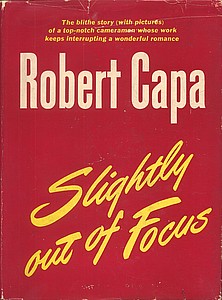
Robert Capa, “Slightly Out of Focus” (1947), cover.
There’s no denying that Capa experienced a failure of nerve at Omaha Beach and hightailed it out of there as fast as he could. He says as much himself, in his 1947 memoir of World War II, Slightly Out of Focus. And the timeline of his trip to and from the front, as indicated by assorted documents, bears this out.
As someone who’s never gone to war, I can’t imagine what it feels like to set foot on ground where bullets and cannon and mortar shells fly, and people die in horrible ways. Omaha Beach that day was a meatgrinder: the official estimate of casualties hovers at 2000. So I don’t fault Capa for running away in that “red badge of courage” moment. It pertains only because his reputation for daring, on which he traded both personally and professionally, would have suffered hugely if that image of him as less than brave had circulated widely. To his credit, he confessed it discreetly in various ways thereafter.
Since it involves what we would have to call a conspiracy, the tale of the negatives’ subsequent processing and supposed destruction proves more perplexing.
In multiple accounts, Morris tells us the following:
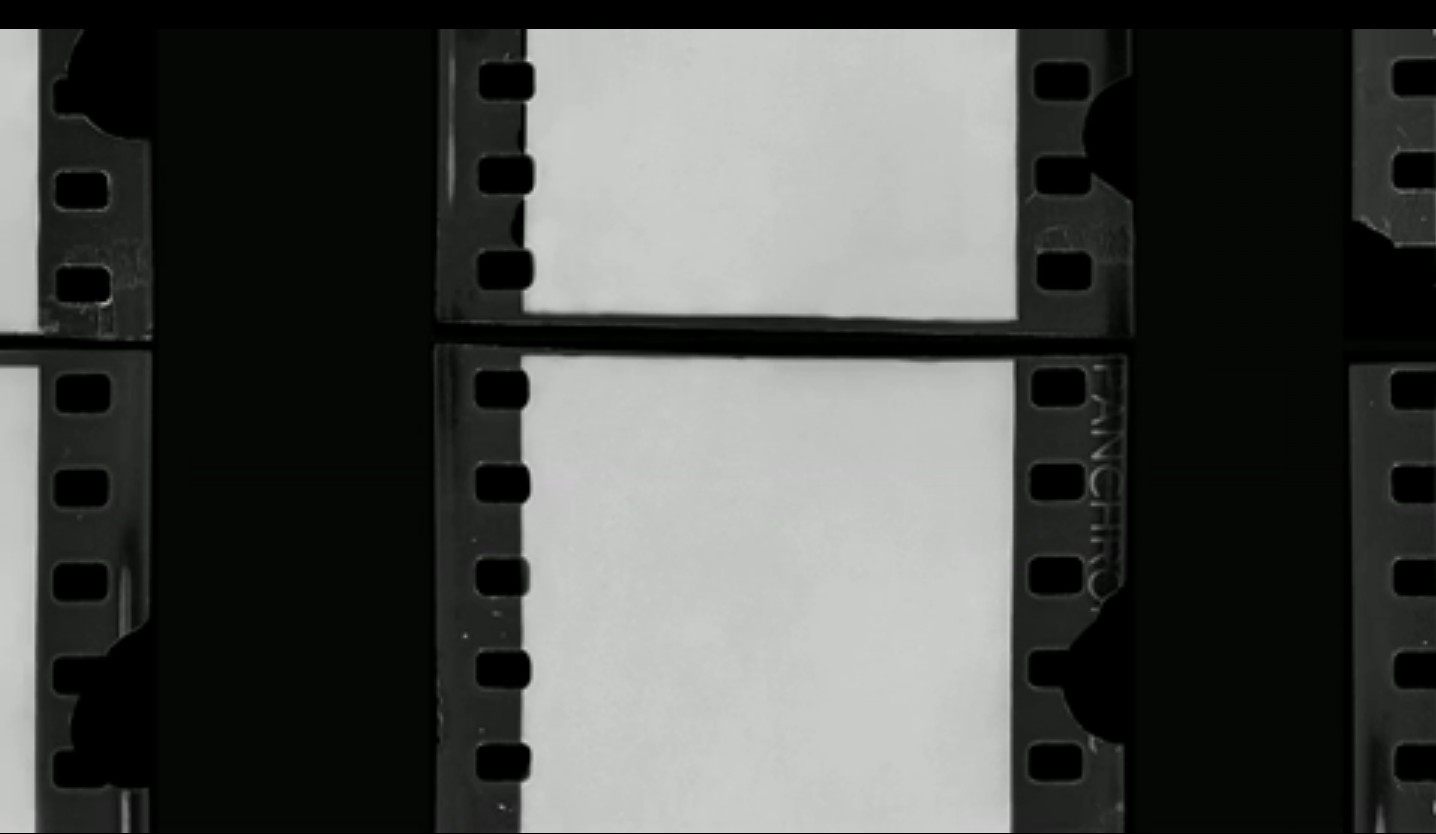
* Robert Capa, spoiled frames from D-Day, June 6, 1944. Courtesy Wikimedia Commons.
- It took Capa’s films an inexplicable 12 hours to travel the mere 140 miles from Weymouth to London via courier.
- Immediately upon their arrival at Time-Life’s offices in London’s Soho district, Capa’s films got sent to the darkroom for developing. Presumably all four rolls of 35mm b&w film would have gotten processed with the same pre-mixed batches of developer, stop bath, and fix, to save time.
- As indicated on the surviving frames, the 35mm rolls were Kodak Super-X Panchromatic Safety film, introduced as a movie film in March 1935, rated at ASA 50 and preferred for its relatively soft, low-grain, low-contrast look. In April 1945 Popular Photography described it as “A film which can be used in all types of outdoor light and indoors under favorable conditions.”
- Dennis Banks, a 15-year-old lab assistant, youngest of the five darkroom staffers, did the developing and fixing, then transported the developed film strips from the lab to the drying cabinet.
- So Banks would have seen the film strips, and presumably would have noticed if three of them, and most of the fourth, were blank.
- Another LIFE photographer, Hans Wild, surely adept at reading negatives, looked at them while still wet — just after development — and pronounced them “Fabulous!”
- The makeshift drying cabinet actually consisted of an unventilated wooden clothes locker with a “heating coil” on its bottom, whose doors they normally kept open.
- Having been instructed by Morris to hurry the drying of the films so that prints could get made (“We need contacts — rush, rush, rush!”), Banks closed the doors of the wooden locker, with the result that, after “only a few minutes,” the cabinet had become so heated that the emulsions on all but a third of one strip had melted into “pea soup.” A tragic loss, especially after Capa had risked so much to make those other, now forever vanished exposures.
- Fortunately, 11 exposures remained intact, and those got printed and published, becoming iconic overnight.
- In the haste and preoccupation of the moment Morris discarded the ruined film strips, later regretting not keeping them because they too would have functioned “iconically.”
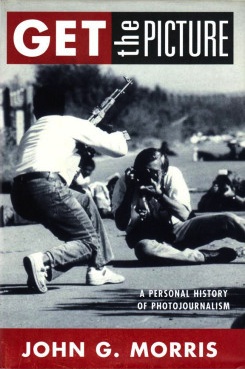
John Morris, “Get the Picture” (1998), cover.
For a sampling of Morris’s multiple variations on this tale, see this extract from his 1998 memoir Get the Picture: A Personal History of Photojournalism; a June 5, 2004 recap for the New York Times; the brief 2010 documentary film “Eleven Frames,” directed by Douglas Sloan; an interview with François Picard for France24 TV on June 6, 2011; this video interview from July 2, 2012; the May 3, 2013 interview by Alessia Glaviano for Italian Vogue, with its accompanying video; this May 31, 2013 interview/profile from the Financial Times; “The Story Behind Robert Capa’s Pictures of D-Day” by Cynthia Young, ICP Curator of the Capa Archives, from June 6, 2013; Get the Picture, a feature-length film on Morris from 2013, directed by Cathy Pearson; “Behind the Photo: Robert Capa’s D-Day,” a brief TIME video from May 29, 2014; and “Robert Capa’s Longest Day,” by Marie Brenner for Vanity Fair, June 2014.
In all its versions, what a dramatic tale. By this time Morris knows it by heart.
My problem: I bought this story when I first heard it, in the late 1960s, and have accepted it as true ever since. But I no longer believe it.
The Dog Ate Capa’s Homework
To begin with, why would LIFE magazine — famous for its lavish budgets and spare-no-expense relation to equipment and supplies — rely on a makeshift film-drying cabinet with no air circulation, cobbled together from a wooden clothes locker and an electric “heating coil”? Surely, if a standard state-of-the-art drying cabinet proved unavailable for some reason, they could have afforded a custom-built one for the photo-processing area of their long-established and otherwise well-appointed offices at 2-4 Dean Street, in the film district of London’s Soho district.
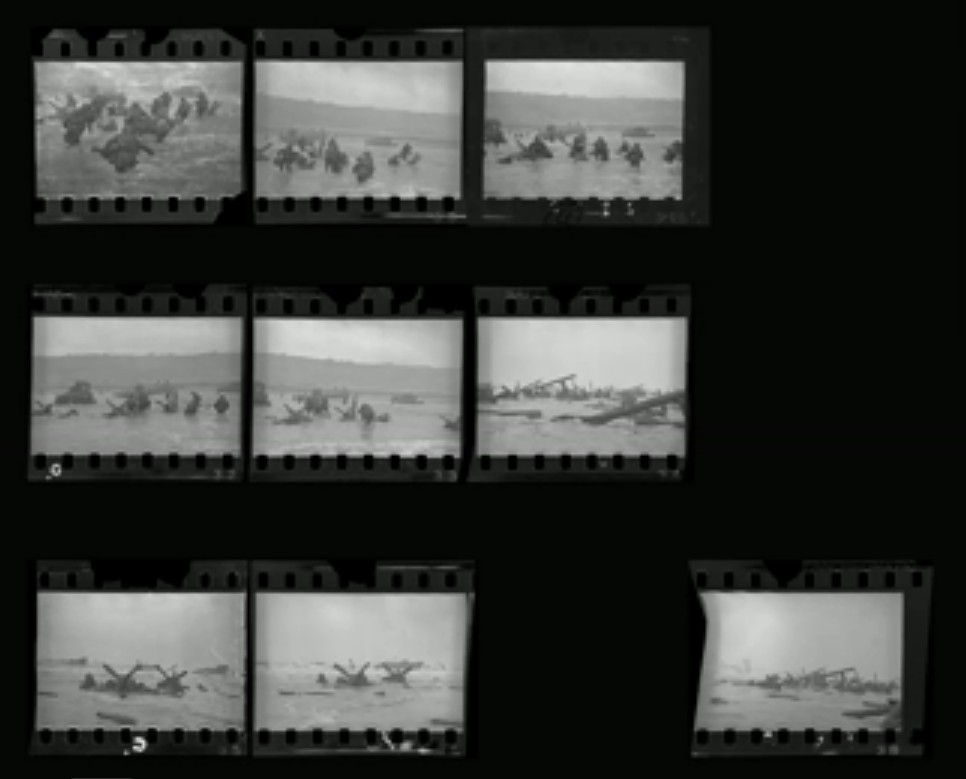
Robert Capa, D-Day frames from 6 June 1944. Courtesy Wikimedia Commons.
Next, I find it implausible that Morris would receive those precious, anxiously awaited, historic, irreplaceable four rolls of film by Capa (arguably the world’s highest-profile war photographer at that juncture, and one of just two LIFE contract photographers going in with the first wave of infantry) only to turn them over to a 15-year-old lab assistant for developing, when, according to Morris, “The darkroom staff — all five of them — had been standing by idly” for a day and a half.
Finally, are we to believe that, having just seen to the successful development of three full rolls of what he knows everyone considers the most important negatives of the battle, with John Morris howling for contact prints, Dennis Banks hangs them in the drying cabinet, closes the doors thereof to speed the drying — but, instead of hovering over them and checking on them minute by minute, does … what, exactly? Steps out for a smoke? Calls his girlfriend? Answers a prolonged call of nature? And the four other “idle” members of the darkroom staff have better things to do than keeping their eyes on these films?
God Said to Abraham, Kill Me a Son
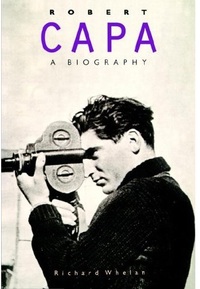
Richard Whelan, “Robert Capa: A Biography” (1994), cover.
Worth noting that Dennis Banks conveniently disappears after D-Day. He’s not mentioned by name in any early account of the loss of Capa’s films, and a brief unsourced quote from Capa magnanimously forgiving him appears apocryphal: “I would never have worked for LIFE again if they had fired Dennis Banks for ruining my negatives.” (Intriguingly, Richard Whelan’s authorized biography of Capa from 1994 gives his name as Dennis Sanders, but I don’t find that repeated anywhere else.)
Indeed, scuttlebutt for years put the blame for the loss of Capa’s negatives on photojournalist Larry Burrows. Burrows, then 18, was indeed there that day; but most accounts, including Morris’s, have him as a “tea-boy” or gofer, without any involvement with darkroom activities. (In the 2010 “Eleven Frames” film Morris exonerates Burrows explicitly, though his June 6, 2011 France24 interview puts Burrows on the darkroom staff.) I’ll hazard a guess that Burrows’s age and presence in or around the lab led to the rumor of his involvement with the Capa fiasco during the years when the story in circulation didn’t mention Banks by name, but only an unnamed teenager.
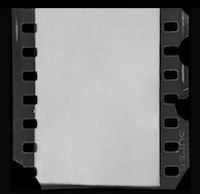
* “Behind the Photo: Robert Capa’s D-Day” (2014), screenshot
The first mention I find of Banks as the culprit comes in Morris’s memoir Get the Picture: A Personal History of Photojournalism (New York: Random House, 1998). By the time that got published Banks had long since vanished from all radar screens; Burrows, shot down over Laos, had died in 1971; and Hans Wild, the only other person who could corroborate Morris’s claim that three of Capa’s four rolls contained a full complement of normal exposures, had died in 1969.
In short, no one alive can corroborate Morris’s account — or contradict it with direct eyewitness testimony. We have only that narrative, and the remaining fragments of physical evidence, and some verifiable facts to go on in confirming or disproving it. On that basis, let’s proceed.
•
(For an index of links to all posts in this series, click here.)
[Note: Subsequent research by Rob McElroy revealed that all supposed examples of Capa’s “damaged” D-Day negatives published in the May 29, 2014 TIME video, such as the ones above (*), were forgeries produced by Magnum in collusion with the International Center of Photography. While this renders irrelevant the above analysis of those frames, it does not undermine my broader challenge to the “melted emulsion” narrative. — A. D. C.]
•
John Morris will participate in a conversation with Robert Pledge, founder and director of Contact Press Images, at the International Center of Photography on June 24, 2014. They’ll stream it, so you can watch it live online at www.icp.org/live. Clicking on that link will enable you to submit a question in advance.






“As I edited and sourced and fact-checked J. Ross Baughman’s bold and thoughtful analysis of Robert Capa’s brief D-Day experience on Omaha Beach”
This is a remarkably paternalistic and condescending way to phrase this. He was your guest and, if you felt that you had to do anything, you should have kept it to yourself rather than implying that you mistrusted your guest’s abilities and thus found it necessary to oversee his column.
Normally, I’ve always taken the punches of criticism that follow one of my stories without further rebuttal, but Lewis Lorton doesn’t seem to understand the relationship between editor and writer, and confuses that process with good manners and hospitality.
While a guest’s tastes and opinions ought to be honored, the best traditions of journalism require that facts be verifiable. Mr. Coleman’s lively, spirited and voluminous give-and-take during the last week of editing could only be described as fraternal, never paternalistic.
I’m pleased that our process inspired Mr. Coleman to continue the investigation, and perhaps others will help set this historic case in its proper light.
Standard journalistic practice includes fact-checking articles by stringers and op-ed pieces by invited guests just as carefully as those by staffers. You could look it up (which would constitute fact-checking): Here’s New York Times op-ed page editor David Shipley on the subject.
Because Ross Baughman makes very serious charges in his posts (a 70-year deception that involves scapegoating and conspiracy), and because his inquiry led me to elaborate and substantiate them, I thought it advisable to ensure that we both had our facts straight as we proceeded. That this surprises you surprises me. That you take offense at it, or think Baughman should, I consider merely silly.
Allan,
I’ve been following your Capa piece with interest. One additional possible reading of the over-exposed frames could suggest that the shutter on Capa’s Contax had jammed or dragged. Had the over-exposure been massively greater there would have been a kind of halation or bleeding of light around the edges of the frame and around the sprocket holes.
I recall Super xx being rated at 100 ASA. One could check out the dates and ASA’s of the Super x and thus determine what might have been the degree of over-exposure. Also the lens probably had a maximum aperture of f/3.5 or f/4.0…..nothing special by today’s standards. The beach was early morning foggy overcast and his film and lens were not all that fast.
I cannot begin to consider the “melting emulsion” idea because from my experience the intensity of heat great enough to melt emulsion would surely be close to the flammable level. It might be interesting to determine the substrate or base of the film that supported the emulsion. I recall cellulose came in as a “safety base” as a result of nitrate movie film combusting during projection as well as storage. So…….
I don’t buy the melting theory……..
Based on the 11 existing frames and the burnt-out over-exposed frames as well as the absence of the other rolls I vote for a mis-firing shutter which could have been the case what with all the salt water spray and chaos……….maybe a grain of sand…. those 35mm cameras of yore lacked the precision we take for granted today. It is true that technical mis-functions were much more common during the 40s and even the 50s when I began my relationship to the medium.
If you think this is a mystery you should try digital………..
Yours to the last drop,
RALPHotographer
Thanks for the input.
Capa’s Super-X had an ASA 50 rating. Not a fast film, likely pushed in developing. I mention this in an upcoming post. The backing wasn’t nitrate, but cellulose/acetate.
Re some shutter malfunction: Baughman gave this thought, as have I. But, within hours of turning his exposed Omaha Beach films over to a courier in Weymouth, Capa returned to Normandy — with the same 2 Contax II 35mm cameras, which he carried through France for the next month, sending back lots more exposed film without any technical flaws.
Both cameras would have had to suffer the same mechanical problem simultaneously. And cameras don’t self-repair. So we’ve discounted that possibility.
i am at a loss as to how Capa reloaded his Contax in those conditions.
you have to remove the back put the film on a removable take up spool.
and then replace the back and lock 2 locks.
the screw mt leicas were only a little easier to load.
If my reading of the hard evidence (Capa’s caption notes for the rolls of 35mm film he sent to London, and the “magnificent eleven” themselves) is correct, Capa never had to change film on Omaha Beach. He exposed only those 11 frames on that one roll, never even using the second Contax he carried.
Not only would the Contaxes have proved troublesome to reload under those conditions, they’d have been impossible to use in the way Capa describes himself as working: “I didn’t dare to take my eyes off the finder of my Contax and frantically shot frame after frame.” Because the Contax lacks an advance lever, you have to turn a knurled advance knob several times to get to the next frame. It’s impossible to do that without taking your eyes off the viewfinder, which in turn makes it impossible to “frantically shoot frame after frame.”*
That this self-mythologizing, in tandem with the mythologizing of him by others invested in his legend, has survived largely unchallenged for 70 years boggles the mind.
[*Note, July 28, 2015: Several photographers have assured me that professional users of these Contax cameras (and others with similar knurled film-advance knobs) learned to press the first digits of their index fingers against the knob and spin it to the next blank frame while still looking through the viewfinder. Not quite as smooth an operation as that enabled by a film-advance lever, but sufficient to enable rapid successive exposures. I stand corrected on that point.]
the “melted” sprocket holes look more like over agitation when the film was developed – more developer rushes past the holes and over develops that area.
Capa had stepped on a landmine. He was alive but his left leg had been blown to pieces, and he had a serious wound in his chest. Capa was taken to a small field hospital, where he was pronounced dead on arrival. The response to sham trackers is there.
The circumstances of Capa’s death are well-known. They prove nothing about his actions on a particular day ten years earlier, nor about the fate of his D-Day negatives.
Couple of technical notes on reloading the Contax II cameras, lenses, and sprocket holes:
1) From what I understood, both the Contax II cameras he carried on D-Day had 50mm lenses mounted on them, identical. I thought that must be because he never planned to reload in the water or under fire, and wanted to give himself 72 frames rather than 36.
2) Those lenses were fast, either f/1.5 or f/2.0 Zeiss. Over-exposure is definitely easy, not only from accidentally misrotating the shutter dial (not that easy to do on a Contax II, because you have to lift it to turn, also, you can hear and feel what shutter speed it shoots at.) But aperture dial is easy to move by accident, and you don’t know.
3) But at ASA 50 in the early morning you’re probably at shutter speed 50 or 100 and wide open or close to it. Even if you’re at f/2.8 or f/4, inadvertently knocking aperture to f/2.0 or f/1.5 would only result in 1 or 2 stops over-exposure, not enough for negative to be completely dense. You also have to develop with too-hot water and/or agitate way too much.
4) Image overlapping sprocket holes is entirely normal for both Contax and Leica screw mount cameras of this era
We came to a very different conclusion as to why those supposedly “damaged” negatives look the way they do in the TIME video. Read Rob McElroy’s analysis.
This research project started over two years ago. We have learned many things since. I suggest you read your way through our work before offering comments on the earlier chapters — we’ve done a fair amount of revision to initial assumptions, based on what we have uncovered.
We come to the same conclusion — I was saying that over-exposure could not have caused this. My conclusion was that over-exposure would only have been 1 or 2 stops at most and not enough to make images unusable. Even with hot developer and too much agitation, creating near “bullet proof” negatives, they can still be printed, albeit with difficulty — and you can treat them with Farmer’s Reducer as well to reduce the over-density.
Of course, as you go on to prove, fakery does create truly unusable negatives!
And you guys came to same conclusion I did regarding sprocket holes — though I didn’t know that the Zeiss and Leica cassettes were slightly different sizes — I always thought it was just standard to have slight overlapping of image area onto sprockets in this era. Almost all images printed full frame from that era have this, see Robert Frank and many many others. I own both a Leica IIIc and a Contax II and both cameras do this, for the reasons you go on to explain.
The most notable aspect of the sprocket-hole intrusion into the image area, in my opinion, is that this effect occurs visibly in dozens and probably hundreds of rolls of Capa’s negatives in the ICP Capa Archive. Neither of the resident curators — Richard Whelan first, now Cynthia Young — needed to understand the minor mechanical misalignment that caused this in order to acknowledge the visual evidence that it happened consistently with Capa’s films, and thus could not plausibly have resulted from some unique darkroom disaster. They simply had to compare the D-Day contact sheets with those immediately before and after in the looseleaf binders.
This makes them either totally incompetent or bald-faced liars.
Dear Alan,
You and I met in Köln, years ago. This frank message to you has been in my head for a long time.
I happened across your page just now, so here it is . .
The late John G. Morris was a acquaintance of mine.
He was an honorable man. His explanation of this incident is completely plausible and I don’t see why he would lie, even taking into account your rather inane conspiracy theory.
Your “theory” consistently minimize one essential point; there was a HUGE war going on, and all of this happened WITHIN that theatre and DURING the action (I mean London, too); There was a war happening; a HUGE one. London was bein bombed. D-Day had just occurred. There was urgency and panic in the air. Shit happens and shit DID happen. Period.
Also, as John often explained, photos had to get to the U.S. via an airplane which took off from SCOTLAND to NYC; then a train to reach LIFE/Chicago in time for laying out, printing and distributing very next edition, in order to scoop other papers and magazines … but BEFORE that –in London– EACH frame of EVERY roll was required, by Allied defense, to be printed as 8x10s, washed, dried and driven over to the military censors, who inspected ech photo and punched holes in the negatives they did not want printed .. Then the film RETURNED to the lab to be packaged and quickly driven up to Scotland in time to catch one of the infrequent and irregular departures. THAT’s why he told Dennis Banks to hurry … and THAT’s why Dennis turned up the heat on the drying cabinet.
When the whole context is considered, the accident in light of that stressed rush because understandable. But no .. instead, you accuse Morris of lying to cover Capa’s ass (as if to say that Capa had never made mistakes before that?). My god, man. That kind of ass-covering would have been unnecessary and totally stupid under those conditions because Morris’ bosses, in NYC and Chicago, while not happy about it, would have understood and accepted such blunders.
Let’s also be clear and consider a point often missed by those who swallow your line of bull-pucky; In your fantasy conspiracy you suggest — or again, you accuse — Morris, Capa AND THE WHOLE FRIKKING TEAM AT THE LONDON LIFE LAB — all of them — of keeping their mouths shut about this “conspiracy” for over 50 or 60 years! You want us to imagine that —— decades after the war — some ex-LIFE guy, somewhere in a bar, drunk, would be telling his buddy this ‘war story’ (or will have told the story repeated to his family) … and would still, under those conditions, remember to LIE in order to protect a long-dead Capa?
THAT’s what you’re suggesting. Eye roll.
Also, about your saying that the London LIFE lab, in 1944, should or could have had, ——in a bombed-out city and rationed country —— “state of the art” darkroom equipment . . . are you KIDDING me? Of COURSE it’s totally plausible that the drying cabinet was DIY. (In fact, even if LIFE in NYC, at that time, had a ‘custom-made’ film drying cabinet, it would not have been a surprise!)
So, Alan, I must tell you that I’ve always found it pretty despicable that you’ve slandered John G. Morris, Capa and the whole LIFE-London team in this way. One has to wonder if it’s actual you, who sought to increase your historical significance by latching-on to this story.
Really despicable, Alan.
There. Now that I’m done being honest, I’ll be more polite:
On a lighter note, someday I’ll send you the photo I took of you with Fritz Gruber (Sorry, but I’m on a “Vivian Maier” schedule of printing a backlog of years of negatives . . . no conspiracy; the negatives didn’t melt, I’ve just have never printed them yet. Please forgive me if I ever kick the bucket before getting to them)
Cordially yours
CN
Can’t say I recall our meeting in Köln.
Apparently you’ve read the first chapter of our journal of a ten-year research project, and based your response on that. I’d suggest working your way through the whole thing before opining, or at least catching up. Here’s a place to start.
At the end of his life, as a result of our published research, John Morris was going on Christiane Amanpour’s CNN show and confessing to the New York Times that he never actually saw any damaged negatives, and that Capa probably made only ten exposures on Omaha Beach. You’ll find all that annotated in the blog posts.
I can live with my “despicability.” Assume you can live with your gullibility — and your willful blindness to the truth. As an experienced professional photographer, you surely know that there’s no darkroom in the world in which “the doors of the film-drying cabinet were normally kept open,” and no such cabinet whose heat controls allow temperature levels that can damage the films. That part of the lie was permanently put to rest by Tristan da Cunha’s experiments, as discussed at the blog.
With that said, I’m intrigued by this in your screed: “EACH frame of EVERY roll was required, by Allied defense, to be printed as 8x10s, washed, dried and driven over to the military censors, who inspected e[a]ch photo and punched holes in the negatives they did not want printed.” On what do you base your assertions of the required print size, and the hole-punching of rejected negatives? LIFE‘s D-Day protocols, which we unearthed and published, do not mention either of these details.